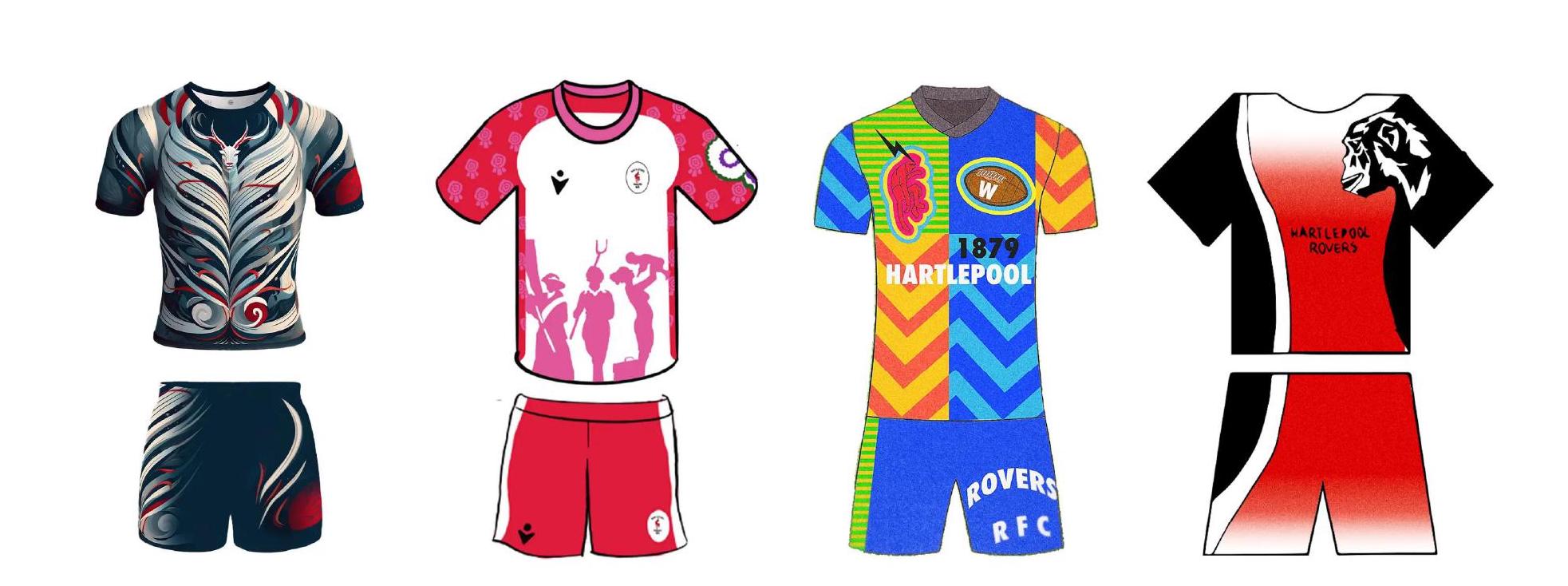Four Designs Shortlisted in Groundbreaking New Women’s Rugby Team Kit open call competition

Four shortlisted designs for the Get Shirty open call competition to design a new women’s rugby team kit are being put to a public vote from the 24 April to 18 May.
The shortlisted designs are by:
Sarah Diante, finalist from Macclesfield has said:
“Inspired by the famous stag (taken from the “Hart” in Hartlepool), this powerful winged design, is a tribute to Hartlepool’s manufacture of the angel of the north with associations of agility and potential, and waves for the town’s connection to the sea.”
Archie Prince finalist from Nottingham has said:
“This design pays homage to Amy Beatrice Norman. Hartlepool’s suffragette activist and close friend of Emeline Pankhurst – the movement that gave women the rights they deserved, and pushed on for more equality.”
Ash Sketch finalist from London has said:
“This boldly designed retro-feel kit features a strong colour palette with a unique pattern of chevrons to ensure the team stand out from the crowd, making a statement of strength and determination.”
Olivia & Gaia Corvi finalists from Lancaster have said:
“This is a collaborative design from two young people who chose a bold depiction of Hartlepool’s symbol of the monkey producing a striking, bold and clean patterned kit.”
Get Shirty is a collaboration between Hartlepool Rovers Ladies Rugby Football Club and Cumbria-based artist led company Eden Arts who teamed up for the new creative opportunity to create a new team kit for Hartlepool Rovers Ladies RFC.
Supported by Hartlepool Borough Council, the competition has seen exciting and iconic designs being shortlisted by a panel of judges including former Exeter Chiefs player, Garnet Mackinder and Hartlepool Ladies Rugby Team Captain, Danielle Jeffreys-Coulton.
Get Shirty is part of Eden Arts’ #66 project funded by Arts Council England that sees a number of projects delivered that focus on supporting the region defined by the A66 that runs east to west from Cumbria to Teesmouth. Great things are happening across the region as it becomes more culturally diverse and successful, greener and more digital and progressive. The #66 projects celebrates the region and its arts and culture and its heritage and proposes a new strategy to ensure that it is seen as the most liveable in the UK, especially for its younger generations.
The recent competition which closed on the 31 March aims to create a kit which is both unique and that the team is proud to wear. Four final shortlisted designs will now be put to a public vote before the winning design is announced on 22 May.
The public are encouraged to vote for their favourite design by heading to https://getshirty.uk/
The winning design will receive a prize fund of £1000, plus £1000 towards an official female sports group of the winner’s choice. The winning design will be announced on 22 May and then be produced and showcased at a special event in early September.
The five judges who shortlisted the four final designs from the competition are:
Garnet Mackinder is currently employed as Head of Equality at Sport England and has recently retired from playing rugby in the women’s Allianz Premier 15s, having played for Saracens, Wasps and Exeter Chiefs. Garnet played rugby for over 15 years; was part of the England U20s squad and was capped for England 7s. Garnet is a co-opted member of the RFU Council with the aim of increasing diversity in rugby and driving forward the women and girls game.
Chelsea Power is Commercial and Operations Director for Emilia Wickstead, the London based Fashion Designer, she works on collection development of the brand. Having worked on various projects, with new designers and consulting she brings a wealth of industry fashion knowledge’.
Danielle Jeffreys-Coulton is Hartlepool Ladies Rugby Team Captain and has been playing rugby for 15 years since attending Teesside University. She previously played for Darlington Ladies and has represented both Durham County and the North-East. Danielle has been a member of the club for six years, she sits on the committee and also coaches the U12 and U14 girls teams at the club.
Charles Quick is Professor of Public Art Practice at the University of Central Lancashire, is founder co-curator of art-led research project In Certain Places which brokers connections between people and places. He has played, coached and helped administrate as a volunteer at his local community rugby club, Roundhegians in North Leeds, for over 25 years.
Adrian Lochhead is the director of Eden Arts, an artist led company dedicated to creating and facilitating change through culture and arts activities. Adrian’s early career encompassed theatre, TV and Radio as a performer, director and writer, as well as with educational arts companies. He is passionate about the relevance of art and culture in enriching all of our lives.






